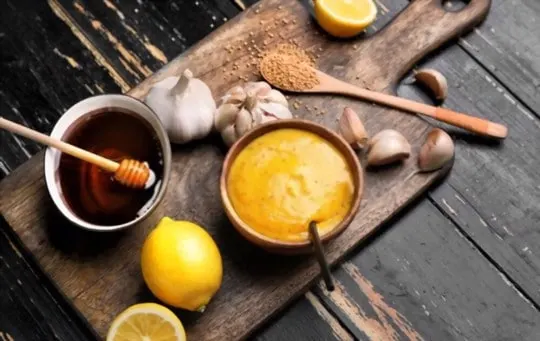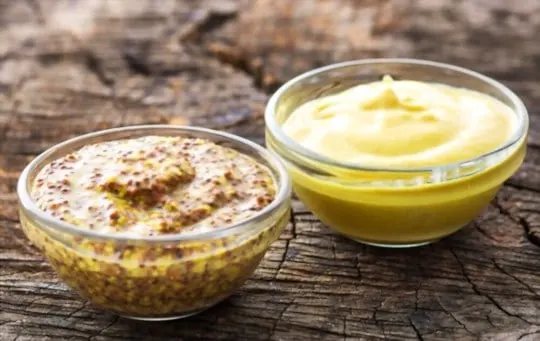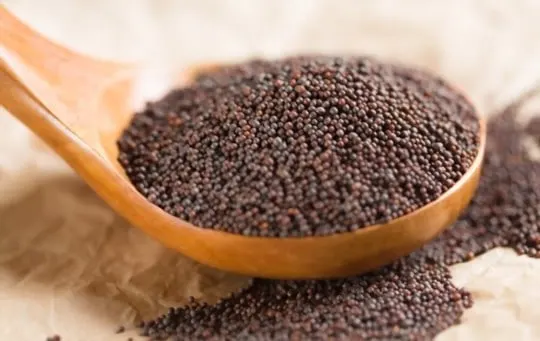Whole grain mustard has a strong flavor that is not to everyone’s taste.
If you are catering to a wider audience or looking for something different, consider using whole grain mustard as an ingredient in your cooking rather than serving it with the meal.
Whole grain mustard is used in very high quantities in many different types of cuisine worldwide because it adds excitement and flavor to any dish.
When it comes to cooking, whole grain mustard is used in a wide variety of different ways because of its complex flavor profile and texture.
A popular way to use this condiment is as a marinade for meat.
This brings out the natural flavors of beef or chicken before they are cooked, resulting in a savory dish.
Whole grain mustard can also be used as a glaze for roasted meats or vegetables to give BBQ food that added kick.
If you’re looking for a substitute for whole-grain mustard, then this article is for you.
Keep reading to find out about five of the best substitutes for whole grain mustard.
What is Whole Grain Mustard?

It’s hard to imagine there was ever when “mustard” wasn’t an item found on grocery store shelves.
It’s such a common condiment; it would be easy to assume that mustard has been around forever.
And one of the most popular types of mustard is whole grain.
Whole grain mustard starts with a base of brown or yellow mustard seeds, ground up, and mixed with water, salt, vinegar, and some sweetener.
The result is a spread that can be rich in flavor without being too spicy for those who don’t taste the hotter varieties.
When the seeds are ground into a paste, it traps the tiny pieces of seed and spices inside.
When mixed with vinegar, whole grain mustard forms a thick liquid then added to other ingredients like eggs or salad dressing for added flavor.
The 5 Best Substitutes for Whole Grain Mustard
Whole grain mustard is known for its distinct texture and tangy flavor, which makes it a popular condiment and ingredient in many dishes.
However, if you find yourself without whole grain mustard or simply want to try something different, there are several substitutes available that can provide similar characteristics.
| Substitute | Key Characteristics | Proper Ratio |
|---|---|---|
| Honey Mustard | Sweet and tangy flavor combination | Use an equal amount of honey mustard as a substitute for whole grain mustard |
| Yellow Mustard | Mild and slightly tangy flavor | Use an equal amount of yellow mustard as a substitute for whole grain mustard |
| Dijon Mustard | Smooth and creamy texture with a tangy and sharp taste | Use an equal amount of Dijon mustard as a substitute for whole grain mustard |
| Tarragon Mustard | Herbal flavor with a hint of anise-like sweetness | Use an equal amount of tarragon mustard as a substitute for whole grain mustard |
| Brown Mustard Seeds | Earthy and pungent flavor with a crunchy texture | Grind brown mustard seeds and use 1 tablespoon as a substitute for 1 tablespoon of whole grain mustard |
Now let’s dive into each substitute in more detail:
1 – Honey Mustard

Honey mustard is a great alternative to whole grain mustard. It’s easy to make and has many uses.
Honey mustard can be used as a spread for sandwiches, as an ingredient in dressings, or as the base of several tasty condiments (think honey mustard dipping sauce) and sauces.
This sauce is best if you can make it from scratch, but that’s not always possible.
In a pinch, though, the store-bought variety is better than nothing.
You can use this condiment on hotdogs, sandwiches, and even salads.
There are many honey mustard recipes available, so it’s worth trying this condiment out on various meals.
Proper Ratio: Use an equal amount of honey mustard as a substitute for whole grain mustard in your recipes.
2 – Yellow Mustard

Yellow mustard is an excellent alternative to whole grain mustard.
It adds bright flavor to salads, spreads sandwiches, and works well even on the simplest hot dog.
This yellow mustard gets its name from the distinctive bright color of the seeds.
And, unlike many other condiments, yellow mustard is typically made from vinegar and water rather than oil.
This means it has a strong flavor that isn’t too greasy or rich.
Proper Ratio: Use an equal amount of yellow mustard as a substitute for whole grain mustard in your recipes.
3 – Dijon Mustard

Like whole-grain mustard in texture, dijon mustard adds a slightly spicy flavor to dishes.
It’s a common ingredient in French cuisine, making a great condiment for hot dogs and sandwiches.
Dijon mustard is made from brown or black seeds ground into a paste before spices and flavorings are added.
The resulting spread is thicker than traditional yellow mustard, but it can be versatile.
In addition, Dijon mustard is popular in the United States, France, and Canada.
And yet, it may not be easy to find in some grocery stores.
In a pinch, though, any Dijon-style mustard will help add a hint of spice to your meal or sandwich.
Proper Ratio: Use an equal amount of Dijon mustard as a substitute for whole grain mustard in your recipes.
4 – Tarragon Mustard

If you like the taste of tarragon with your meals, this is the mustard for you.
Tarragon mustard has a bold flavor that adds interest to dishes.
But, unlike dijon or honey mustard, it’s smooth and creamy instead of harsh and crunchy.
Add it to sauces or a spread or dip for meats and vegetables.
Tarragon mustard is typically made the same way as regular whole grain mustard, but instead of regular seeds, it uses tarragon seeds.
This makes it spicier, with a strong licorice flavor that works well on many dishes.
It’s also an excellent complement to foods like chicken or steaks.
Proper Ratio: Use an equal amount of tarragon mustard as a substitute for whole grain mustard in your recipes.
5 – Brown Mustard Seeds

Brown mustard seeds are an excellent substitute for whole grain mustard when you need a lot of flavor in your meal.
The seeds come from the brown mustard plant, related to the cabbage family.
It’s ground into a paste using vinegar and then flavored with other ingredients like lemon juice or honey to taste.
Brown mustard seeds have a deep, rich flavor that can be as spicy as dijon mustard or as mild as yellow.
This is a great substitute if you want to try something different from traditional whole-grain mustard.
Proper Ratio: Grind brown mustard seeds and use 1 tablespoon of ground seeds as a substitute for 1 tablespoon of whole grain mustard in your recipes.
Conclusion
Whole grain mustard is a delicious condiment.
However, when you need to avoid gluten or other ingredients in whole grain mustard, it’s time to look for alternatives.
Fortunately, there are many great substitutions available.
Honey mustard, yellow mustard, Dijon mustard, tarragon mustard, and brown mustard seeds all make excellent replacements for whole grain mustard.
And, if paired with the right foods, they can help you make amazing meals that will impress even your pickiest eaters.

The 5 Best Substitutes for Whole Grain Mustard
Ingredients
- Honey Mustard
- Yellow Mustard
- Dijon Mustard
- Tarragon Mustard
- Brown Mustard Seeds
Instructions
- Pick your favorite substitute from the list above.
- Follow cooking directions for your selected substitute with the proper ratio of ingredients.

Andrew Gray is a seasoned food writer and blogger with a wealth of experience in the restaurant and catering industries. With a passion for all things delicious, Andrew has honed his culinary expertise through his work as a personal chef and caterer.
His love for food led him to venture into food writing, where he has contributed to various online publications, sharing his knowledge and insights on the culinary world. As the proud owner of AmericasRestaurant.com, Andrew covers a wide range of topics, including recipes, restaurant reviews, product recommendations, and culinary tips.
Through his website, he aims to inspire and educate fellow food enthusiasts, offering a comprehensive resource for all things food-related.

Leave a comment